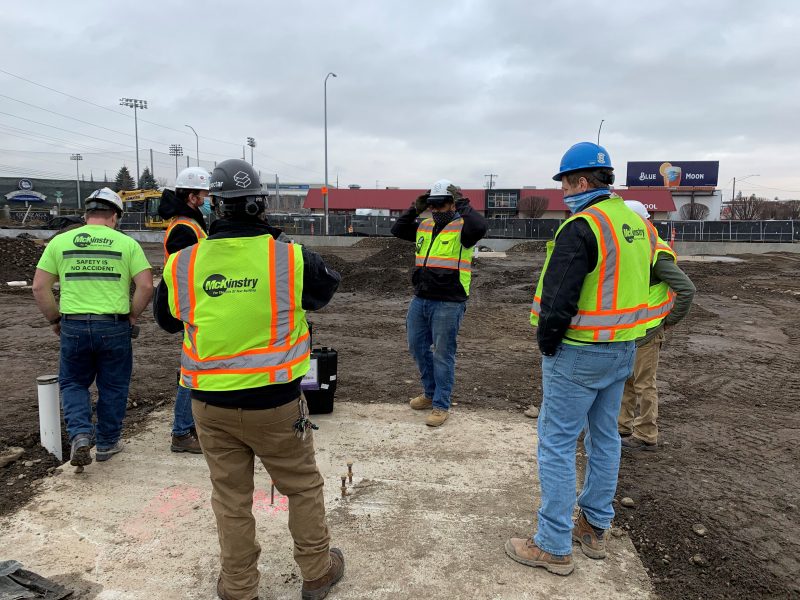Join McKinstry live on October 7, 2021 at 2:00 PM PT for the much-anticipated Autodesk University session, Successful Digital Transformation Through a Product Management Organization. The industry talk will be led by Dace Campbell, Director of Product Management for McKinstry and full of actionable insights.
Firms are adopting new technology at a rapid rate today — but they aren’t necessarily implementing solutions to their full potential. There are plenty of reasons behind this, though the most common ones are largely related to budget and staff.
In a 2020 study by JBKnowledge, respondents were asked what they considered is the top limiting factor in trying and/or adopting new technology at their firms. Nineteen percent of respondents cited budgetary reasons and another 19% pointed to the lack of staff to support new tech. Meanwhile, 17% cited employee hesitance as their top limiting factor in technology adoption.
The construction industry clearly has challenges when it comes to tech adoption and implementation, and this was even more apparent during the pandemic, when companies struggled to stay connected. If there’s one thing that the year 2020 taught us, it’s the importance of being technologically fluent at every step of the construction process.
Fortunately, there are companies such as McKinstry, which are setting the bar high when it comes to establishing processes and strategies for better technology adoption.
As a large specialty contractor, McKinstry has a unique perspective on construction teams and technology.
The company understands that the structure of many AEC firms aren’t conducive to technology adoption. IT departments are often disconnected from high-level business objectives, which makes execution difficult. What’s more, calculating the ROI of technology — plus measuring the opportunity costs of not adopting tech — isn’t a clear-cut task.
McKinstry has a way to address this with their Product Management Organization (PdMO). We’ll get into the details below, but this organization of strategic thinkers guides implementation of critical, ROI-boosting technology for their clients at every step of the construction process.
Simply put, McKinstry’s PdMO is able to efficiently connect the threads of common need across all lines of a business.
Let’s take a closer look at the issues that many builders face and how McKinstry is helping.
What stops builders from making informed business decisions?
Industry-wide pain points — which often come in the form of inefficiencies, confusion, and mistakes — lead to a whole lot of wasted time and money on projects. As Brian Antonsen, VP of Mechanical Construction at McKinstry put it, “At McKinstry, we believe that half the energy in buildings is wasted, and half of construction costs are waste.”
While pain points may vary from one builder to the next, they often share the following themes.
Disconnected stakeholders
Project teams are composed of several people in a variety of roles. Difficulties arise when these stakeholders struggle to articulate needs or plans, especially when it comes to important details such as dates and scopes. Problems can also come up when extended stakeholders can’t access the info they need because of multiple points of data entry. These issues can leave people in the dark and wreak havoc on a project’s timeline.
Inability to forecast effectively
Not having access to reliable data is a major pain point for builders because it prevents them from planning effectively. Without accurate forecasting, teams can easily mismanage their time and budget.
Manual and cumbersome processes
The lack of automation in projects means teams have to manually carry out tasks like entering and reviewing data. On top of that, manual processes are often fraught with human error and duplication of tasks, which of course is time and labor-intensive.
Poor coordination across different locations
Construction work doesn’t just happen on the jobsite. With people working remotely as well as being in the office, teams are often scattered across different locations. When builders don’t have tight systems that connect various team members, projects suffer.
Inefficient task and progress management
Tracking progress is critical in any project. Unfortunately, many builders have difficulties doing so because of uncoordinated task management. What’s more, many teams rely on guesswork based on outdated data.
Uncertain estimates
The lack of data and inefficient procedures also lead to inaccurate and uncertain estimates, which means builders can’t get a solid handle on the scope and cost of the project. This results in a poor bidding process and overall experience.
“At McKinstry, we believe that half the energy in buildings is wasted, and half of construction costs are waste.”
The above-mentioned pain points greatly hinder builders from making informed decisions.
Fortunately, the folks at McKinstry have come up with a way to attach real dollar figures and other metrics to just about every pain point a builder could face. This is extremely valuable, because it enables their team to quantify not just their ROI, but the opportunity cost of not using technology to address their pains.
How a PdMO can help firms pivot to digital workflows
How exactly does McKinstry’s PdMO help transform their digital workflows? Let’s explore how a PdMO can truly be revolutionary for firms struggling with technology adoption and decision-making.
What is PdMO?
Before we go any further though, it’s worth defining what “product” means in the context of PdMO. The “product” is essentially a technology solution being developed and deployed. That could be in the form of software, a website, an app, etc.

Example of Augmented Reality (AR), a technology product, in use on a real job site. Image courtesy of McKinstry
Product Management Organization (PdMO) then refers to the team responsible for implementation of those technology solutions, or “products”. Essentially, it acts as a strategic organization chartered with implementing, managing, and measuring the impact of technology to ensure alignment between the organization’s technical roadmap and business needs
Some specific responsibilities of a PdMO are to identify market opportunities and commercial viability for new products, guide development, launch and management of technology — all the way to the eventual retirement of that technology. More often than not, the technology the PdMO helps implement is an internal enterprise system, set of tools, or solution that addresses a firm’s specific business need.
The Product Management Organization streamlines a firm’s digital transformation processes, ensuring that the technology being adopted truly addresses the business’ needs. They develop success metrics that align with a desired outcome. Then measure business improvement or progress towards that outcome.
How McKinstry’s PdMO works
McKinstry’s PdMo gives them a framework for innovation with enough structure and predefined processes to be effective in executing projects. They’re able to develop products, or technology solutions, on the fly with minimal business disruption. This allows them to implement the right technology at the most optimal time for the firms they’re supporting. This is typically done on a five-year Construction Technology (ConTech) Roadmap.
By fully digitizing all lines of business and projects, they’re able to serve as designers, contractors, and manufacturers – operating in and across multiple industries in the same enterprise. Ultimately, McKinstry’s PdMO enables them to iron out a firm’s technological needs, so they can reap the benefits and see an ROI much faster.
As one example, according to Dace Campbell, Director of Product Management in Construction at McKinstry, their PdMO is an essential resource to the success of the company’s data standardization efforts

A construction field crew pilots new technology to validate uses cases & identify business value — in support of diagnosing before they prescribe a solution. Image courtesy of McKinstry
“Best practices championed by our PdMO include a ‘“diagnose before you prescribe’” approach, with a thorough discovery process to identify pain points, root causes, and impacts of not having data standards,” he says.
“By qualifying and quantifying this pain in terms of business value, we can articulate and prioritize the need to standardize our data among other important process and technology improvements across our enterprise.”
McKinstry’s PdMO also allows their teams to be more agile and adapt to the changes to their market, so they can stay competitive.
Why is measuring implementation of technology important?
The common line, “you can’t improve what you don’t measure,” rings very true in construction technology.
Successful digital transformation isn’t just about adopting the newest tools. You also need a way to track and measure the performance of your initiatives. Metrics such as your ROI, profit, productivity, and opportunity costs should be quantifiable and accessible — meaning team members shouldn’t have difficulty finding, sharing, or applying data to make better business decisions
Since McKinstry is able to prescribe real dollar values to its technology solutions through its PdMO, business leaders have a clear understanding of what they’re getting out of technology and what they could be missing out on.
Ultimately, this helps McKinstry’s clients make informed decisions around technology and beyond.
Other notable innovation initiatives at McKinstry
Aside from their Product Management Organization, McKinstry is also leading a number of projects that empower their teams to innovate and accelerate digital construction workflows faster.
Such projects include McKinstry’s 2020 Construction Hackathon, a two-day event involving 50 employees across multiple backgrounds and departments. The Hackaton encouraged participants to come up with innovative solutions to minimize waste in design and construction.

The McKinstry team makes progress on new technology as part of their 2020 Construction Hackathon. Image courtesy of McKinstry
There’s also MSUITE, a cloud-based shop management platform designed to connect BIM, Fab, and field construction teams. MSUITE has a Shop Manager capability that enables you to improve production efficiency in manufacturing as well as gain visibility into shop performance data. And thanks to the PdMO, McKinstry is well along its way to implementing MSUITE across their network of shops, with just a few more trades to go in a few more locations.
Bringing it all together
As the construction industry continues to advance, the need to efficiently implement technology grows. A Product Management Organization is one strategy that builders can emulate to do just that. A “PdMO-like” approach enables firms to assess their needs and ensure that they always have an effective technology roadmap.
Thanks to McKinstry’s ability to attach quantifiable and qualifiable business value to technology, the firm is setting an example in how to properly measure implementation of new technology. And they’re able to make smarter, more informed business decisions because of it.
To close on some learned wisdom, when implementing any construction technology solution — whether operating with a formal Product Management Organization or not — McKinstry recommends you “define a clear change management process, identify the business problem, quantify business value, and align outcomes and success metrics to ensure you meet the needs of your business.”
Sage advice.
Learn more about McKinstry by checking out their website
The post McKinstry Paves the Way for Smoother Tech Adoption in Construction appeared first on Digital Builder.
